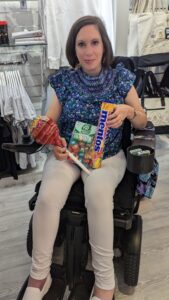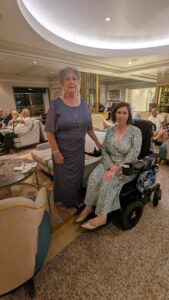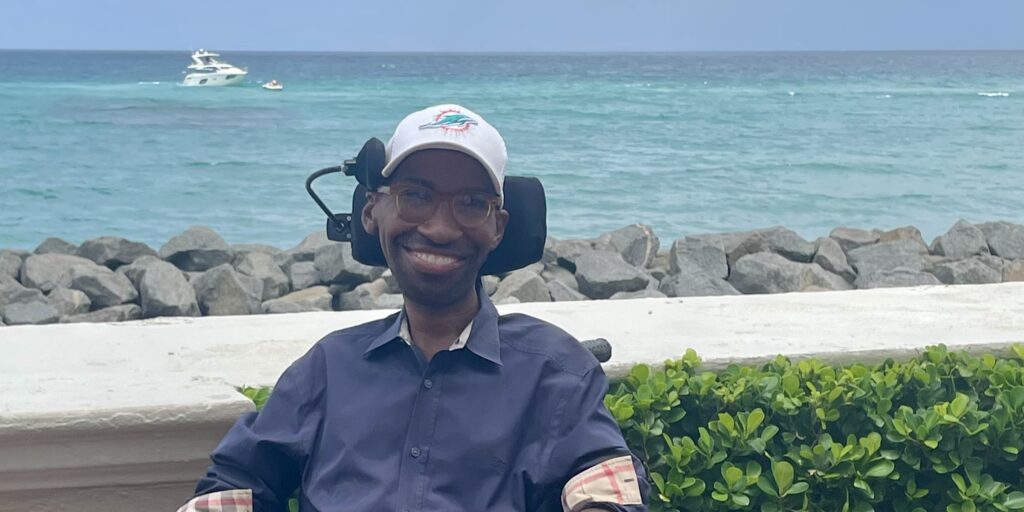
MDA Ambassador Guest Blog: The Sailing of a Lifetime
By Victoria Nedza | Tuesday, April 16, 2024
5 Second Summary
MDA Ambassadors play an essential role in furthering MDA’s mission while representing and empowering the neuromuscular disease community. Quest Ambassador Guest Blog series provides a platform to share their personal stories, perspectives, and experience.
Living in Pennsylvania with her son, Victoria is an active volunteer with her local newspaper, parent-teacher organization, and LGMD News magazine as an Assistant Editor. Her social media accounts are a one-stop shop for adaptive products for the neuromuscular community.

Victoria Nedza shopping on the cruise
Traveling outside of the country has always been on my bucket list if time, money, and ease of accessibility weren’t deterrents. For many reasons, including the limitations in accessibility and the risk of damaging my lifeline of a wheelchair, flying doesn’t seem like a feasible option to me. And as much as I love road trips, venturing out to explore the United States didn’t hold the same allure that it did in my twenties. Cruising, therefore, became the best option, because I could bring all the comforts of home aboard a giant ship. I didn’t want any ordinary adventure. I wanted an elevated experience aboard the last ocean liner sailing across the high seas. Cunard’s Queen Mary II’s esteemed reputation offered grandeur, elegance, and grace. And best of all: It was fully accessible to me!
Embarking on a two-week transatlantic journey roundtrip from New York City was the trip of a lifetime. Given that I live within a 2-hour commutable distance from the city, I could bring as much luggage as I fancied. Yes, girls, that means ball gowns, shoes, and three daily outfit changes. And more practically speaking, all of my durable medical equipment.

The Cunard Queen Mary II Queen’s Room
While planning my trip, I completed a mobility questionnaire, detailing the exact dimensions of my motorized wheelchair, which bathroom fixtures (shower chair, raised toilet seat, extra grab bars) were needed, and if I needed special assistance navigating the ship. It is important to be transparent to ensure that your needs will be met. And some cruises, including Cunard, will not allow you to board with your mobility device if you did not declare it in advance. My booking agent walked me through everything and even provided me with pictures of the bathroom beforehand and its equipment. Cunard also just updated the accessibility portion of their website and has even more detailed information about mobility aids, service dogs, and where to get larger equipment delivered to the cruise terminal (s).
I strongly suggest when traveling to ask as many questions as you’d like and to confirm more than once as due diligence serves us well. If I was unable to find the information that I needed online, I called and checked in with a booking agent. A few of the questions that I asked included: 1) What is the width of the stateroom doorway? 2) Where are the help call buttons located in each room? Are they also available in public bathrooms? 3) Is there a pool lift available in the private spa or any of the public pools? 4) If you have a dietary restriction (allergy, kosher, vegan, etc.), how do you decide on your custom menu? Do the food menu options change daily? By gathering as much information as I could and discussing the accommodations that I required in order to stay safe and access all that the ship had to offer, I felt prepared to embark on the adventure of a lifetime.

Victoria Nedza and a friend
When I arrived at the docking terminal on the first day of my trip, I was given priority boarding. I rolled right up to the front of the line and was pleasantly surprised that all of my heavy medical equipment was already safely delivered to my room. My private stateroom on the ship was the perfect size for my Permobil wheelchair. As many can imagine, stateroom doors must be heavy for fire prevention purposes, but I was able to independently open and close them. I even had a few inches of clearance through the doorway. The bed was the ideal height to self-transfer, and I could do a 360-degree turn with ease. Each accessible bathroom had a roll-in shower with multiple strategically placed grab bars, a vanity to roll under, and a phone for emergencies. I was especially pleased to find adjustable shelves in the closets and light switches and plugs that I could reach while sitting at the desk or on my king-sized bed.
The entire time I felt at ease knowing that this was my home away from home. If I needed medical attention, it was available right away. If I asked for help cutting my food, a maître d’ was right there to help me. As any person with a disability, hidden or visible, we need to take extra steps in planning our next adventure so we can anticipate the unpredictable. While I was on the cruise, I didn’t have to think what if or prepare for the unexpected, because I had already done the planning and I knew the services available to me. Being comfortable in my physical surroundings meant I could finally just relax and enjoy my vacation!

Victoria Nedza dining on the cruise
My favorite part of the trip was having the ability and accessibility to partake in all of the activities that I was interested in trying. I had access to activities like watercolor classes, chair yoga, a birds-eye view of the Captain’s Bridge, and an excursion to the ship’s salon. As a young(ish) woman and full-time wheelchair user, it can often be a pain point to feel “pretty” in my chair. Naturally, I welcomed the opportunity to dress up for gala nights, put a little makeup on, do the hairdo, and feel like a woman again. The opportunity to enjoy all that the cruise had to offer, sail across the seas, and just relax and have fun without worrying about accessibility or barriers was priceless. Hands down, my experience with cruising was so pleasurable that I’m planning my next transatlantic voyage for this summer.
Next Steps and Useful Resources
- Learn more about Limb-girdle muscular dystrophy (LGMD) here.
- MDA’s Resource Center provides support, guidance, and resources for patients and families. Contact the MDA Resource Center at 1-833-ASK-MDA1 or ResourceCenter@mdausa.org
- Listen to a conversation with advocates pushing for advances in accessible air travel and transportation policies at MDAQuest.org/podcast/ accessibility-DOT.
- Find smart tips for affordable travel in our guide to accessible travel on a budget.
- Stay up-to-date on Quest content! Subscribe to Quest Magazine and Newsletter.
TAGS: Ambassador Guest Blog, Ambassadors, Travel
TYPE: Blog Post
Disclaimer: No content on this site should ever be used as a substitute for direct medical advice from your doctor or other qualified clinician.




